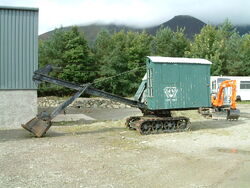| Line 40: | Line 40: | ||
** Wolf Mk.III |
** Wolf Mk.III |
||
;Crawler cranes |
;Crawler cranes |
||
| − | *[[Priestman |
+ | *[[Priestman Lion 40H]] |
| + | *[[Priestman Lion 50H]] |
||
| + | *[[Priestman Lion 85H]] |
||
*[[Priestman LC 51]] |
*[[Priestman LC 51]] |
||
*[[Priestman MC 250]] |
*[[Priestman MC 250]] |
||
| + | *[[Priestman MC 300]] |
||
*[[Priestman MC 350]] |
*[[Priestman MC 350]] |
||
| + | *[[Priestman MC 400]] |
||
**[[Priestman MC 350 Lion]] |
**[[Priestman MC 350 Lion]] |
||
**[[Priestman MC 350 HD]] |
**[[Priestman MC 350 HD]] |
||
Revision as of 08:43, 5 April 2009

Priestman VC15 Long reach at Threlkeld Quarry

Priestman Cub shovel at Threlkeld quarry 2005

Priestman dragline restored in British Waterways colours

Priestman Mustang at Threlkeld 2005

Early Priestman face shovel
Priestman started in Hull in 1876.
History
The Priestman story began when William Dent Priestman in 1876, who had founded an engineering firm in Hull six years earlier, was asked to build a winch and grab for work off the west coast of Spain, in an attempt to locate lost gold. Though nothing was ever found, the mechanism that William Dent created was found to be equally effective at dredging mud and silt in docks, rivers and harbours.
It was used soon after at Hull Docks – with such success that it was soon in demand all over the world. Success after success followed, before the firm went into liquidation in 1895.
Restructuring followed, and Priestmans began to shine brightly once more. By the First World War, its cranes were being used to rebuild French villages , and by 1921, a small "ditcher" for field drainage was produced, followed by funding from the Ministry of Agriculture for further developments.
Face shovels, dragline excavators and backactor ditching machines as well as power grabs became the mainstay of the expanding Priestman company.
In 1928, Priestmans produced the first of their "animal-named" excavators. Such names as the Lion, Tiger and Panther would later become synonymous with Priestmans. Early machines were very crude with the driver sitting next to the engine.
The machines an be configured as Draglines, Face Shovel, Bach hoe, Skimmer and Cranes, by changing the Jib / Boom and ancillary equipment.
Work started on their Marfleet base in 1950. It would eventually cover 63 acres in Hull, and by 1963, when the firm embraced hydraulic power, it had long been a household name.
In the 1970s they developed a range of hydraulic excavators. The VC range of dredging machine with long reach booms to replace draglines. his had an innovative sliding counter weight to balance the boom at long reach. These were popular with small sand and gravel pits and with the drainage board and water companies in Lincolnshire for cleaning dykes. They also built special versions on tall pedestals for dock side un-loading duties.
In 1984 they merged with Sanderson of Skegness in Lincolnshire. Sanderson group got into trouble in the early 1990s and the Priestman operations were sold to another local company RB Cranes following there break up of the Ruston-Bucyrus group. They were then taken over by NEI Group and merged with the Coles Cranes of Sunderland operation and, began building offshore cranes for North Sea oil rig platforms.
Today, what is left of the firm trades in Bradford under new owner, Gardner Denver, the american based compresser and blower manufacturer. No longer are cranes or excavators manufactured. The replacment parts business became unsustainable after the last Priestman emplyee retired in 2007. All the drawings and specifications exist. These are all in storage slowley deteriating with age. The legacy lives on ?.
Model Range
- Crawler cranes & Universal excavators
- Priestman Cub
- Priestman Hydro-Cub - early part hydraulic machine
- Priestman Beaver Mk I 1965 (Hydraulic version of Cub)
- Priestman Hydro-Cub - early part hydraulic machine
- Priestman Lion
- Priestman Panther
- Priestman Tiger
- Priestman Wolf
- Wolf Mk.I
- Wolf Mk.II
- Wolf Mk.III
- Crawler cranes
- Priestman Lion 40H
- Priestman Lion 50H
- Priestman Lion 85H
- Priestman LC 51
- Priestman MC 250
- Priestman MC 300
- Priestman MC 350
- Priestman MC 400
- Priestman MC 350 Lion
- Priestman MC 350 HD
- Hydraulic excavators
- Mustang Mini (Priestman badged Tecushi model) 3 machines in range.
- Priestman Mustang range
- Mustang 120 Perkins 6.354 / Ford 365 engine option
- Mustang 150 (wheeled version of 120)
- Mustang Swing Shovel - A 120 with 1¼ Cu yd front shovel gear
- Mustang 160 16 ton servo control Ford engine.
- Mustang 220 22 ton servo control Perkins V8 / G.M.engine option.
- Mustang 320 - 30+ ton m/c Perkins V8 engine ? (rumoured to be only 4 built)
- Mustang 108 S Ford 365 6 cyl
- Mustang 168 FORD 380 6 cyl turbo.
- Mustang 2-12 (Sanderson) Ford 4 cyl.
- Mustang 2-11 Wheeled version of 2-12 (Sanderson)
- Mustang 2-15 (Sanderson)Perkins 6.354
- Mustang 2-18 (Sanderson)Perkins 6.354
- Priestman VC excavators
Preserved Machines List
- Collection of machines in Adrian Pattersons collection at Threlkeld, Cumbria.
- Cub Mk.1 - 1933 up to the last Mk.6 - 1969
- Wolf
- VC 15 - 1984 machine s/n 4178 fitted with a Perkins A6.354 engine, and 10 roller tracks for riverbank works.[1]
- Priestman 120
- Priestman Mustang 120 - 1979 (2 no.)
- Beaver Mk I of 1965 (S/N A12202) @ Threkeld, fitted with Lister HB4
- S.E. Davis & Son Ltd. have a Cub in their collection, at Astwood Bank Redditch.
See also
- List of Construction Plant Manufactures
- Ruston (engine builder)
- Ruston-Bucyrus
- NCK
- NCK Rapier
- Ransomes & Rapier
- Vintage Excavator Trust
- Shows and Meets
- Collections
References
- Classic Plant & Machinery Magazine
- Web site on Coles (see below)
Links
| ||||||||||||||||||||||||||||||||||||||||||||